

FETHiYE
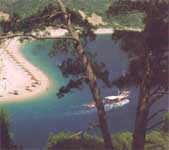 Town, southwestern Turkey. It lies along a sheltered bay in the
eastern part of the Gulf of Fethiye on the Mediterranean Sea that is
backed by the western Taurus ranges. Fethiye's enlarged port is an outlet
for the minerals and timber of the region. The hinterland is a major center of
chromium mining. Fethiye stands on the site of the ancient Lycian city of
Telmessus, whose remains include spectacular rock tombs and sarcophagi dating
from the 5th-4th century BC. Other landmarks include a ruined Byzantine fortress
on the summit of a nearby hill. Much of the town is new, having been rebuilt
after a disastrous earthquake in 1958. Picturesquely situated with several
Lycian sites nearby, notably Xanthus, Fethiye is a growing tourist center
linked by sea with Izmir and Istanbul. Pop. (1990 prelim.) 25,690
Town, southwestern Turkey. It lies along a sheltered bay in the
eastern part of the Gulf of Fethiye on the Mediterranean Sea that is
backed by the western Taurus ranges. Fethiye's enlarged port is an outlet
for the minerals and timber of the region. The hinterland is a major center of
chromium mining. Fethiye stands on the site of the ancient Lycian city of
Telmessus, whose remains include spectacular rock tombs and sarcophagi dating
from the 5th-4th century BC. Other landmarks include a ruined Byzantine fortress
on the summit of a nearby hill. Much of the town is new, having been rebuilt
after a disastrous earthquake in 1958. Picturesquely situated with several
Lycian sites nearby, notably Xanthus, Fethiye is a growing tourist center
linked by sea with Izmir and Istanbul. Pop. (1990 prelim.) 25,690
Fethiye
is a pretty town at the hillsides of the Mount Mendos, the part of the Tourus
Mountain chains, and surrounds the bay that it has given its name to. The high
mountain range formed by rises and falls of the crust during the Tertiary
Geological Period, and hundreds of bays lying at the mountainside seem to
embrace each other along the Fethiye shore line. This mountain range (it was called the Kragos and Antikragos in the antique period) with an altitude of more
than 6560 feet (2000m.) forms the southwest end of the Toros (Taurus) chain and
lies parallel to the shore without a single passage to the inner regions. On a
warm and sunny winter day, peculiar to the Mediterranean climate
while you are sipping at your Turkish tea or Turkish coffee, at one of the local
tea gardens, along the coast, these mountains with pine trees at their skirts,
white snow and mist on their summits will once more welcome you to heaven. Dry,
long, hot summers and short, warm, rainy winters are climatic characteristics of
Fethiye . The temperature which is around 86-105 F (30-40 C) during the summer,
is usually above 50 F (10 C) in the winter. Considering the fact that in these
turquoise-colored seas that in no season falls below 60 F (16 C) swimming is
possible for nine months of the year, we might as well conclude that there are
only two seasons in Fethiye : Spring and Summer!
called the Kragos and Antikragos in the antique period) with an altitude of more
than 6560 feet (2000m.) forms the southwest end of the Toros (Taurus) chain and
lies parallel to the shore without a single passage to the inner regions. On a
warm and sunny winter day, peculiar to the Mediterranean climate
while you are sipping at your Turkish tea or Turkish coffee, at one of the local
tea gardens, along the coast, these mountains with pine trees at their skirts,
white snow and mist on their summits will once more welcome you to heaven. Dry,
long, hot summers and short, warm, rainy winters are climatic characteristics of
Fethiye . The temperature which is around 86-105 F (30-40 C) during the summer,
is usually above 50 F (10 C) in the winter. Considering the fact that in these
turquoise-colored seas that in no season falls below 60 F (16 C) swimming is
possible for nine months of the year, we might as well conclude that there are
only two seasons in Fethiye : Spring and Summer!
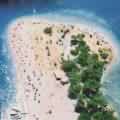 Due to the prevailing climatic conditions
in the region, pine forests consisting of silver fir, Scotch fir, and Norway
spruce cover the place. Olive, laurel, myrtle, acacia, plane tree, and popular
trees are some other types that you can find in this rich flora. the
frankincense tree (Liquidamber Orientalis) which is the source of myrrh widely
used in the pharmaceutical and cosmetics industries, is among the rare species
in the world. This plant has survived for 10 million years and has remained in
existence since before the ice ages is cultivated only around Fethiye and
Koycegiz and in a small district of
Due to the prevailing climatic conditions
in the region, pine forests consisting of silver fir, Scotch fir, and Norway
spruce cover the place. Olive, laurel, myrtle, acacia, plane tree, and popular
trees are some other types that you can find in this rich flora. the
frankincense tree (Liquidamber Orientalis) which is the source of myrrh widely
used in the pharmaceutical and cosmetics industries, is among the rare species
in the world. This plant has survived for 10 million years and has remained in
existence since before the ice ages is cultivated only around Fethiye and
Koycegiz and in a small district of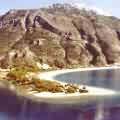 California. You may reach this natural and
historical heaven that God has donated to nature by any of one of the land, air,
or sea courses that you chose. You
could have a comfortable journey to Fethiye by the three highways through the
pine forests, with connections to Mugla, Antalya and Burdur. Scheduled bus trips
in all three directions provide the link between Fethiye and other cities. The
nearest center for air travel is the Dalaman Airport 31 miles (50 kms.) to
Fethiye. In addition to the year round Istanbul - Izmir - Ankara and Antalya
connected flights of Turkish Airlines,
there are direct flights to all major cities in Europe, Asia and America. During
the touristic season, Fethiye's having the fourth largest seaport after
Iskenderun, Mersin and Antalya provides great ease of marine travel. The
naturally protected harbor is a drop-by place for all yacht crews.
California. You may reach this natural and
historical heaven that God has donated to nature by any of one of the land, air,
or sea courses that you chose. You
could have a comfortable journey to Fethiye by the three highways through the
pine forests, with connections to Mugla, Antalya and Burdur. Scheduled bus trips
in all three directions provide the link between Fethiye and other cities. The
nearest center for air travel is the Dalaman Airport 31 miles (50 kms.) to
Fethiye. In addition to the year round Istanbul - Izmir - Ankara and Antalya
connected flights of Turkish Airlines,
there are direct flights to all major cities in Europe, Asia and America. During
the touristic season, Fethiye's having the fourth largest seaport after
Iskenderun, Mersin and Antalya provides great ease of marine travel. The
naturally protected harbor is a drop-by place for all yacht crews.
CYANEAE
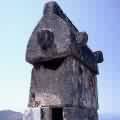 Cyaneae is
a Greek name meaning "dark blue". It is not known why the city was
given this name. It is certain however, that this was one of Lycia's important
cities, given it strategic location and its large settlement area. Although it
is listed by almost all the ancient geographers, they give no information at all
about it. What little knowledge we have comes from a few inscriptions. One of
these concerns a wealthy citizen ofs Cyaneae named Jason. During the reign of
Emperor Antoninus Pius (138-161 A.D.) Jason is found donating money to the
region's cities and receiving the title of Lyciarches, or chairman of the Lycian
League.
Cyaneae is
a Greek name meaning "dark blue". It is not known why the city was
given this name. It is certain however, that this was one of Lycia's important
cities, given it strategic location and its large settlement area. Although it
is listed by almost all the ancient geographers, they give no information at all
about it. What little knowledge we have comes from a few inscriptions. One of
these concerns a wealthy citizen ofs Cyaneae named Jason. During the reign of
Emperor Antoninus Pius (138-161 A.D.) Jason is found donating money to the
region's cities and receiving the title of Lyciarches, or chairman of the Lycian
League.
The city, situated atop a steep hill rising to the north of today's village
of Yavu, is enclosed on three sides by fortification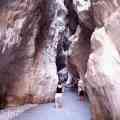 walls. Only on the south, where natural barriers make access difficult, did the
residents not feel the need for fortifications. These walls, which for the most
part date to later periods, are of poor construction, employing re-used
materials gathered from here and there. Three standing gates on the north and
west walls gave entrance to the city.
walls. Only on the south, where natural barriers make access difficult, did the
residents not feel the need for fortifications. These walls, which for the most
part date to later periods, are of poor construction, employing re-used
materials gathered from here and there. Three standing gates on the north and
west walls gave entrance to the city.
Hidden among trees and brush on a hill that can be called the acropolis, are structural remains. A Roman bath, consisting of compartments whose function is not yet known, can be seen in the south-west section of the hill. A little further on ıs a splendid fourth century B.C. sarcophagus, still partially buried, with a relief-carved lid a body inscribed in Lycian.
Cyaneae's best preserved structure is its second century A.D. theatre on the west of the acropolis. Set in a natural slope, the cave, which rises on small polygonal blocks, numbers eleven tiers of seats, and probably held wooden supports for awnings unfurled to protect the spectators from the sun. The stage is in such a poor state of preservation that it yields no clue as to its construction.
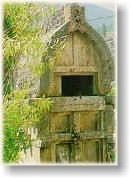 On the path
between the theatre and the acropolis is the necropolis area containing hundreds
of sarcophagi. Here one feels one has returned to an ancient era. Almost all of
the sarcophagi which exist here, and a variety of forms not seen elsewhere in
Lycia, are Roman in character.
On the path
between the theatre and the acropolis is the necropolis area containing hundreds
of sarcophagi. Here one feels one has returned to an ancient era. Almost all of
the sarcophagi which exist here, and a variety of forms not seen elsewhere in
Lycia, are Roman in character.
Rock-cut tombs of early date are located on difficult to reach cliffs on the southern face of the hill. A tomb resembling a simple lonic temple is especially interesting. According to the Greek inscription on its door, the actual sarcophagus belonged to one Perpenesis and his wife, while the remainder of the tomb was divided among their relatives. The inscription also states that the tomb was not to be opened without the consent of the mindis, apparently an official organization that protected the tombs from vandalism and robbery. The tomb has been dated to the third century B.C.
![]()
Home | Ana
Sayfa | All About Turkey | Turkiye
hakkindaki Hersey | Turkish Road Map
| Historical Places in Adiyaman | Historical
Places in Turkey | Mt.Nemrut | Slide
Shows | Related Links | Guest
Book | Disclaimer | Send a Postcard | Travelers' Stories | Donate a little to help | Getting Around Istanbul | Adiyaman Forum
|
|